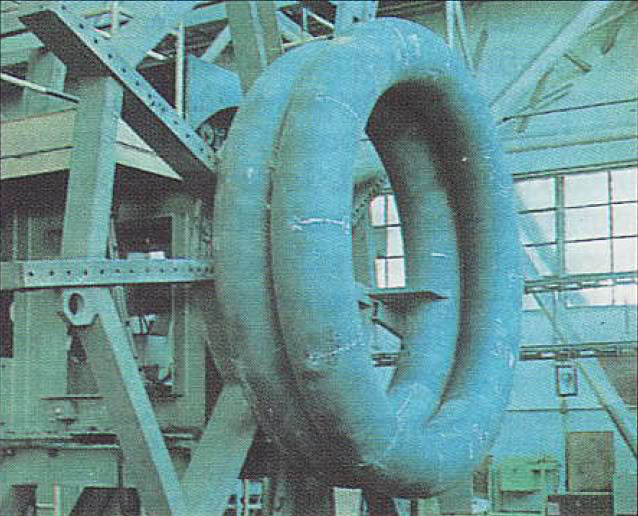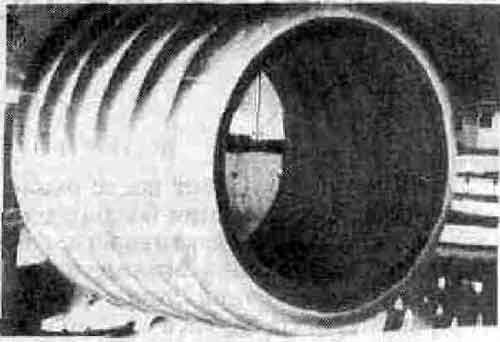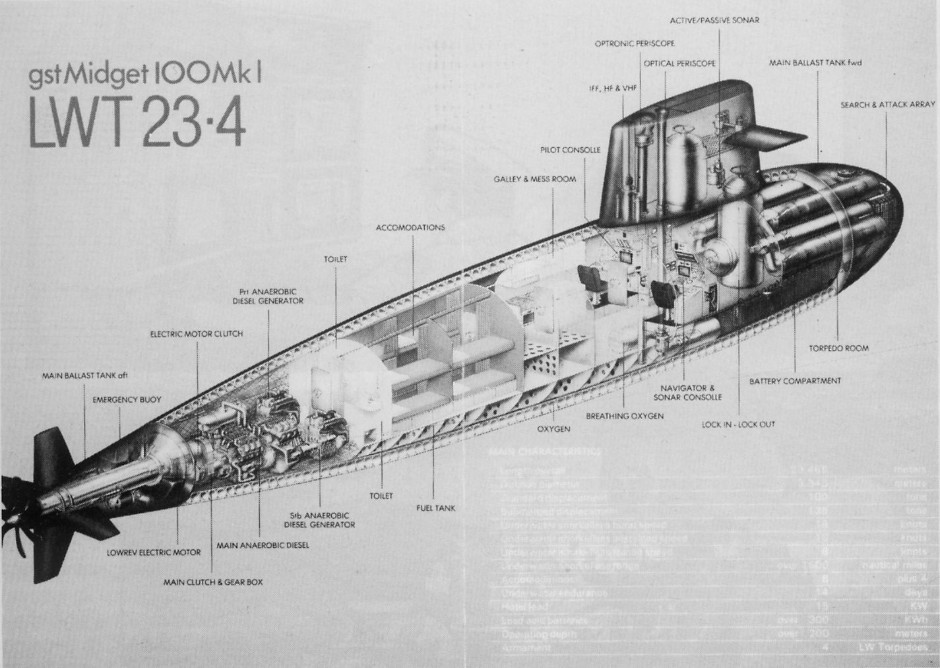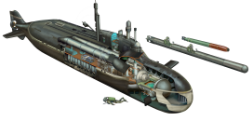 At the end of the Cold War a small firm from Italy promised to shake up the submarine world with pocket-sized AIP (Air Independant Propulsion) submarines. The designs represented a completely new way of constructing submarines. A series of prototypes proved the technology but the end of the Cold War combined with commercial factors consigned most of the designs to the drawing board. Today they are almost forgotten.
At the end of the Cold War a small firm from Italy promised to shake up the submarine world with pocket-sized AIP (Air Independant Propulsion) submarines. The designs represented a completely new way of constructing submarines. A series of prototypes proved the technology but the end of the Cold War combined with commercial factors consigned most of the designs to the drawing board. Today they are almost forgotten.
Original artwork - CLICK for HIGH-RESOLUTION (1600px) image.

Although the shape appears sterotypical of a submarine, the unique construction method allows each part of the hull to be a slightly different diameter and thus a more hydrodynamic teardrop form.
Ordinary submarines are built out of sheets of steel welded together and bent into pecise tubes which are then welded or bolted end-to-end to form a cylinder. In the 1970s Italian inventor Giunio Santi designed a way to build submarines out of lengths of pipe welded togeher like a series of donnuts. These would be used to store gas, specifically oxygen, which could then be used to run a diesel engine even when the submarine is underwater. Combined with filtering and storing the exhaust gases in the same tubular hull, this allowed true Air Independant Propulsion (AIP) with no exhaust emissions at all. This construction was termed Gaseous Oxygen stored in the Toroidal pressure hull (GST). The oxygen was stored at incredibly high pressures (350 atmospheres) thus allowing a huge volume of gas to be carried which translated into impressively long ranges.


And all other things being equal, GST is 5 times stronger than steelplate construction.
LWT 23 Midget Submarine

Designed to be larger than the same firm's highly regarded 3GST9 design, the GST100 series were in the class of Special Operations motherships rather than dry-SDVs. Two 21" or four 17.7" torpedo tubes could be mounted in the bow just behind the main sonar array. Although the rear of the torpedo tubes was inside the hull they were essentially external tubes which had to have been loaded through the front of the torpedo tube. The tubes were provided with impulsors to launch the torpedoes, a capability often ommitted from other small boats to save weight.
Specification
Length: 23.26 meters
Beam: 3.34 meters
Displacement: 100 tons surfaced, 136 tons submerged
Powerplant: Closed-cycle (AIP) 420hp with 15kw eletric motor driving 7-blade screwback prop. Battery for back-up and ultra-quite running.
Speed: 8 kt cruise, 18 kt maximum
Operating depth: 200m
Endurance : 14 days, 1600 nautical miles at cruising speed (AIP) or 400 nautical miles at 16kts
Armament: 4 x 450mm (17.7") lightweight torpedoes or 2 x 533mm (21") heavyweight torpedoes. Mines
Crew: 8 + 4 Combat swimmers.
The ultimate book of Special Forces subs Covert Shores 2nd Edition is the ONLY world history of naval Special Forces, their missions and their specialist vehicles. SEALs, SBS, COMSUBIN, Sh-13, Spetsnaz, Kampfschwimmers, Commando Hubert, 4RR and many more.
Check it out on Amazon
LWT 27 Class Midget Submarine
Slightly larger member of GST-100 family with extra accomodation.

Specification
Length: 27.1 meters
Beam: 3.14 meters
Displacement: 100 tons surfaced, 136 tons submerged
Powerplant: Closed-cycle (AIP) 420hp with 48kw eletric motor driving 7-blade screwback prop. Battery for back-up and ultra-quite running.
Speed: 8 kt cruise, 18 kt maximum
Operating depth: 200m
Endurance : 14 days, 1600 nautical miles (AIP)
Armament: 4 x 450mm (17.7") lightweight torpedoes or 2 x 533mm (21") heavyweight torpedoes. Mines
Crew: 12 + 4 Combat swimmers.
20-GST-48 Class Small Attack Submarine
Designed in the late 1980s this was much larger than the GST-100 family. The designation suggests a boat constructed out of 20" tubes and being between 48.0m and 48.9m long.
Specification
Length: 48 meters
Beam: 5.25m
Displacement: 1000 tons submerged (some sources suggest only 300 tons)
Powerplant: two diesels (400hp) and a 800hp electric motor.
Speed: At least 8kt
Operating depth: 400m
Endurance : 66 days, 3500 nautical miles at 8kt, 7000 nautical miles at 5kt
Armament: 4 x 533mm (21") torpedo tubes and/or 36 mines
Crew: 12 + 8 Combat swimmers (some sources state 12 combat swimmers)
S-300CC Class Midget Submarine

Designed in conjunction with Italian submarine builder Fincantieri, the S-300 design was introduced in 1989 and was reportedly aimed at South East Asian countries including Indonesia, Malaysia, Singapore and Thailand. Unlike the other GST types this used a more conventional tubular shape with verticle bow similar to the Sauro Class SSK then in service with the Italian Navy.
Specification
Length: 33.15 meters
Beam: 3.65 meter
Displacement: 260 tons surfaced, 300 tons submerged
Speed: Maximum 16 kt submerged
Operating depth: 300 meters
Endurance : 1400 nautical miles submerged at 6kt(AIP)
Armament: 4 x 450mm (17.7") lightweight torpedoes.
Crew: 12 plus 8 combat swimmers
MS-200 Class Midget Submarine

A Fincantieri design from the 1990s, the MS-200 was an evolution of the S-300CC design.
Specification
Length: 28 meters
Beam: TBC
Displacement: 250 tons submerged
Speed: Maximum TBC
Operating depth: TBC
Endurance : TBC
Armament: TBC
Crew: TBC
Related articles (Full index of popular Covert Shores articles)


 USN Navy SEAL's UOES3 (Button 5.60) Dry Combat Submersible (DCS)
USN Navy SEAL's UOES3 (Button 5.60) Dry Combat Submersible (DCS)


 Yugoslav X-Craft (R-3E / 911 Class)
Yugoslav X-Craft (R-3E / 911 Class)

 USS X-1 X-Craft
USS X-1 X-Craft

 Japanese Ko-Hyoteki midget submarine of WW2 - Pearl Harbor attack
Japanese Ko-Hyoteki midget submarine of WW2 - Pearl Harbor attack

 Comex Sagittaire midget submarine
Comex Sagittaire midget submarine

 Soviet Project 1015 'SPLC' Special Purpose midget submarine
Soviet Project 1015 'SPLC' Special Purpose midget submarine

 Iranian Nahang Class midget sub
Iranian Nahang Class midget sub

 Piranha Class (LOSOS) midget sub. w/Cutaway
Piranha Class (LOSOS) midget sub. w/Cutaway

 Cos.Mo.S Nessie Fast SDV submersible boat
Cos.Mo.S Nessie Fast SDV submersible boat

 Cos.Mo.S CE4F 4-man SDV
Cos.Mo.S CE4F 4-man SDV

 Narwal / Orca Dry Combat Submersible (UWTG)
Narwal / Orca Dry Combat Submersible (UWTG)

 COMSUBIN's submersible boat
COMSUBIN's submersible boat

 Cos.Mo.S CE2F chariot
Cos.Mo.S CE2F chariot




 World survey of Special Operations Craft
World survey of Special Operations Craft

